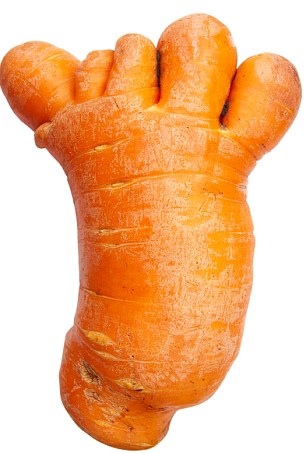There’s a lot to learn from Loblaws decision to sell less attractively shaped fruit and vegetables for 30 per cent less than their more stylish counterparts on the other side of the produce runway.
Loblaws is not only the leading supermarket in Canada. It’s also a retailing pioneer that draws on the marketing knowhow of a multi-billion dollar global empire of trend-setting products in parent company Weston’s stable of brands, retailers and processors — one of which is French Intermarché, who successfully launched the whole trend of selling disfigured food a year ago.
Some of what’s revealed by the sale of what Loblaws now packages as “naturally imperfect” produce is a lot uglier than the bumpy potatoes, apples and carrots that have heretofore suffered exclusion from the food supply.
First, like most things in life, food is all about perspective.
The consumer perspective, central to supermarket success, starts at the main entrance where the eye immediately catches the produce aisle to the right. Produce is almost always placed there to create an illusion in shoppers’ minds that they have just entered a safe, healthy and abundant place — not a department store where candied cereals, over-salted soups and sugary mixes and drinks are positioned where “eye level is buy level.”
The brand is quicker than the eye.
The wandering and whimsical eye, not the brain, is what supermarkets count on engaging, even if it requires distortion of the shape, size and look of real fruits and vegetables — with looks that have been manipulated in a version of photo-shopping and primping akin to what happens to supermodels.
Appearances can be deceiving. Some foods, most notably Florida’s all-red tomatoes, are purely designed to duplicate a warm summer color in a winter iceberg salad. Tomatoes gain their perfect color inside a truck, since they were picked green, before the red was brought on by ripening under the sun. According to Barry Eastabrook, author of the acclaimed Tomatoland, Florida’s tomatoes have few, if any, nutrients that their bright colouring suggests.
What we see is not always what we get. Sometimes we buy more than is needed. Small apples never made it to the shelf until now, for example, because apples are sold by the pound. Small kids with small mouths might like small apples — indeed, many kids in Ontario enjoy the small apples donated to schools by farmers sickened by the idea of land-filling perfectly tasty and nutritious apples. But they don’t make the right ring at the cash register.
Sometimes, we get more than we bargain-shop for, as is often the case with blemish-free apples grown in humid areas such as Ontario or Nova Scotia. As often as not, such apples have a perfect complexion because they’ve been doused with fungicides that eliminate the nasty-looking, but otherwise harmless, blotches caused by fungi, which thrive in humid climates.
Shiny produce, much like shoes, may owe their shine to wax, which seals in otherwise-volatile petrochemicals sprayed on their skin.
Looks can sometimes kill, our eyes rarely tell us.
The second reality revealed by Loblaws change of mind about naturally shaped produce is the absence of any government or any other force (a vigilant consumer-rights charity, for example) charged with protecting the public interest.
Food companies externalize their brightly-colored and blemish-free marketing costs onto the general public.
This happens in one of two ways. Any additional health costs from unnecessary herbicides or fungicides, or from produce bred for appearance at the expense of nutrition, are inflicted on individuals who become sick, and on taxpayers who pick up the tab for healthcare.
The financial costs of land-filling food rejected for cosmetic reasons, as well as plasticized packages chosen because they tempt and prompt shoppers (as distinct from simpler packages that protect food from damage during storage or transit) are picked up by municipal taxpayers. The environmental costs of such dumping are picked up by who-knows-who, as landfills starved of oxygen give off methane emitted by rotting produce — some 20 times more potent from a global warming standpoint than carbon dioxide.
Although governments are missing in action, a big positive is worth noting.
This is a victory for the young and under-resourced food movement.
I know the value of the food movement’s impact because of personal experience.
In 1999, Rod MacRae, Lori Stahlbrand and I wrote a non-bestseller, Real Food for a Change, which exposed, among other things, the waste imposed on the food system by cosmetic rejection of food. Not a blip was stirred.
In 2002, I worked with Bob Spencer, then with the Ontario Association of Food Banks to establish a million-dollar kitchen that could convert what we called “cosmetically challenged food” into carrot juice, apple sauce and mashed potatoes and more — enough to feed all who came to food banks in Ontario with food that looked and tasted great. Top chefs volunteered to supervise the cooking, and regular staffing was provided by youth previously at-risk of homelessness — a measure that led a federal civil servant in charge of homelessness to fund the million-dollar kitchen.
Other than that, not one government or corporation donated one dime, and the project floundered without a peep of protest.
Little more than a decade later, and food movement education about the authenticity and integrity of real food and the scandal of food waste when a billion people are starving, have broken through the silence.
Not to take away anything from credit due to the Loblaws-Weston initiative, the credit needs to go to a movement as yet without much in the way of power or resources, but with many important stories to tell.




